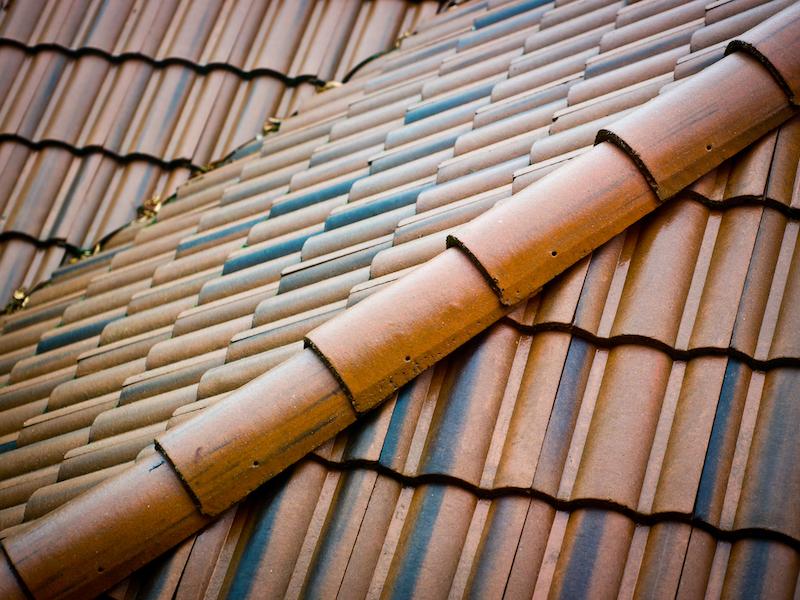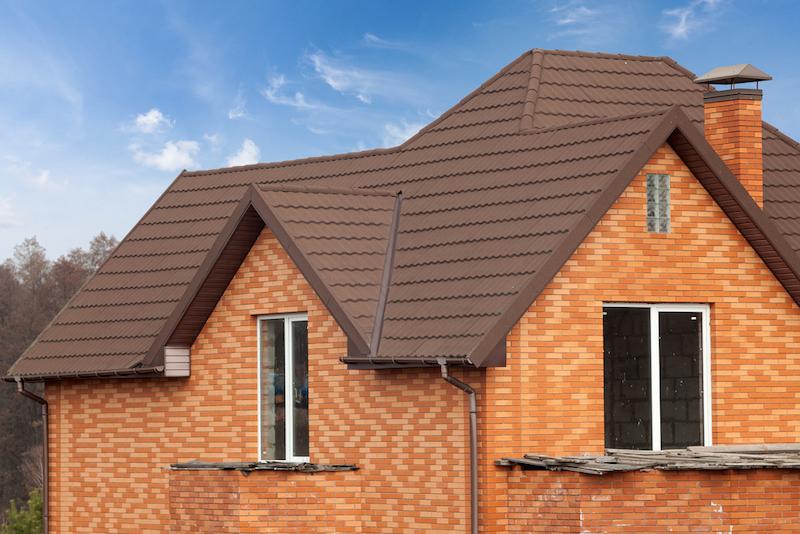A Gentle Introduction to 12 Types of Roofing Materials

Are you in the market to replace the roof on your home? There are many common types of roofing materials to choose from, but if you live in the United States, chances are good that you currently have some form of asphalt shingles—either inexpensive 3-tab or upscale architectural shingles. If you like the look and the longer life span, then your work is done.
But, if you're open to exploring a more expensive type of roof that has interesting benefits, then read on.
Different popular roofing materials come with varying benefits. Examples of such benefits include the ability to withstand strong winds and other severe weather conditions, ease of installation, aesthetic appeal, lower average cost, and longer life expectancy.
Asphalt Shingle Roof
The fiberglass in different types of asphalt shingles supplies strength, making this type of roof a popular choice. The asphalt, usually combined with other minerals, prevents water from passing, completely averting water damage to the roof structure and the building. This makes asphalt shingle roofing a popular choice in wet climates.
The ceramic granules provide shingles their color and help divert UV light. Comparatively light, cheap, and simple to install, asphalt shingles are the go-to option for most homes. They are available in sheets layered onto a roof to provide the illusion of more expensive roofing materials—like slate or cedar—which are set up one shingle at a time.
Standard, entry-level 3-tab shingles are the cheapest option and the lightest in weight. They are marginally thicker and designed to resemble more expensive wooden shingles. Multilayered architectural shingles are the most costly and thickest and provide an appearance similar to wood replacements.
Read more about asphalt and architectural shingles
Ceramic Roofing Tiles

Ceramic tiles add elegance and texture to a roof. This makes them one of the most popular options for roofing materials. They generally require additional framing on the roof to accommodate the weight.
Ceramic roofing tiles come with several advantages. For instance, they are energy-efficient, long-lasting, and do not decay over time in different climates. However, they tend to be heavy and expensive.
Concrete Tiles
Concrete tiles are an excellent choice for homes. They are an affordable option and come in a variety of colors. These tiles have similar characteristics as ceramic tiles or clay tiles. Because they tend to be considerably heavy, concrete tiles are suitable for areas where wind damage is common.
Apart from the fact that they come in a wide variety of colors, they can also be designed to take a variety of styles and profiles. For instance, you will find some of them taking a low profile akin to flat shingles while others take a high profile, like rolled tiles.
Green roofs

Green roofs are one of the fastest-growing roofing styles for both commercial and residential buildings. This type of roof is sometimes referred to as an eco roof or a vegetative roof. These are the most environmentally friendly types of roofs.
As the name suggests, a green layer of vegetation is planted on top of a building when installing a green roof. To ensure that water does not permeate the roof, a layer of waterproofing is installed before putting the soil from which the plants grow.
Going green is one of the best ways to improve curb appeal. Considering that green roofs are covered with plants, they can improve air quality, lessen water runoff, and insulate homes to reduce urban heat islands. Their projected life span is 40 years.
Metal Roofing
A metal roof can be built from aluminum, steel, copper, and even more expensive metals in a variety of shapes and textures. Since metal roof shingles can effectively reflect sunlight, they may keep your home cooler in summer—an advantage in warmer climates.
Be sure to hire a contractor who's experienced in installing roofs made from metal sheets since the metal panels are more expensive and less forgiving than asphalt.
Rubber Roofing
Rubber roofing is supplied in rolls that are installed on flat roofs as long, overlapping sheets. Seams are overlapped to help in house insulation and prevent air leaks. They are attached with strong roof glue.
Rubber roofs present several advantages. One of the primary ones is that they have a low environmental impact. How so? Because the material used to make the overlapping sheets is mostly recycled from used tires, slate dust, or sawdust.
Another reason why rubber roofs are becoming more common is that they last a very long time compared to other traditional roofing materials. In this case, a long time means between 30 and 50 years. Added to this, roofs made from rubber require low maintenance.
Installing a rubber roof is complicated business. Therefore, to get the benefits of using this type of roofing material, you will need the services of an experienced contractor. The upfront costs may be high, but if you consider a rubber roof's life span, along with the fact that it requires little maintenance, you will realize that you will save in the long run.
Read more about rubber roofing
Slate Roofs
Slate is durable, fire resistant, expensive, and heavy. Many consider it to be the most attractive roofing material (and perhaps the roofing material most likely to impress your neighbors). Expect to add additional framing to your roof and make sure you hire roofers that have decades of experience.
If you don't have a pocket deep enough, there is no need to worry; you can get faux slate roofing shingles. This roofing material comprises different compositions, including asphalt, rubber, plastic, or clay. Even though it looks like real slate, faux slate weighs much less. This means that there is no need to alter the roof structure, as would be the case when dealing with the original slate.
Solar tiles
Solar tiles work like solar panels, turning sunlight into electricity. However, they aren’t invisible—they are often integrated side-by-side (but noticeably) with other types of roofing materials. They are especially great for homes that are part of HOAs (homeowners' associations) that prohibit solar panels. While they can help offset energy prices with solar energy, they also cost more than conventional solar choices.
One of the main advantages of using solar tiles is that solar tiles are three times stronger than traditional roofing materials. You can expect these tiles to continue covering your house and producing energy for up to a quarter-century. This implies that solar tiles will pay for themselves over the long run as you save on your energy bill.
Read more about solar shingles
Vinyl Roofing
Vinyl (or "PVC") roofing is a durable roofing product sold in membrane sheets and shingles.
Some eco-friendly PVC roof shingles are made from a mix of recycled materials, vinyl, and cellulose fiber. However, other vinyl roofing shingles are made of natural limestone and resins. PVC shingles are installed in much the same way as slate tiles, or cedar shakes with galvanized roofing nails.
Stone-Coated Steel Roofs

While metal roofs have been in use for ages, they tend to be less appealing to the eye. This is the challenge that stone-coated steel roofs solve. This type of roof is made from steel coated with ground stone. Acrylic film is used to attach the stone chips to the metal.
One of the main advantages of stone-coated roofs is their longevity. Most stone-coated roof installations come with a lifetime warranty, making this an excellent option for public or industrial buildings whose roofs do not have to be changed too often.
Wood Shingles and Cedar Shake Roofing
Wood shingles make for beautiful roofing but are trickier to set up. These shingles are made from thin, wedge-shaped timber, such as yellow pine or cedar. This means that you should be prepared for the cost of professional installation if you decide to go with this type of roofing material.
Be aware that growing fire dangers in certain areas have generated legal limitations on the usage of timber roofing materials. Wood roofs are certainly not a fantastic alternative in almost any place with a dry, hot climate and strong winds, where seasonal wildfire dangers pose a serious risk.
Read more about cedar shingles
Plastic Roof Shingles
Even though it may sound counterintuitive, plastic roofs are a good choice when you need a material that is fire resistant. This is because the material used for making these shingles comes with a Class A level of fire rating, implying that they can resist extreme heat.
Before You Install Your Roof
Regardless of which kind of material you choose and whether you are replacing an entire roof or just repairing an existing one, using common roofing materials, or something more sophisticated, make sure you hire a trustworthy roofing contractor or company.
Get a written warranty that covers both the materials and labor, and make sure that you understand how to correctly care for your roof so that it can continue to serve you and your house for decades to come. Above all, ensure that you select a roofing material suitable for the climate in your area.
